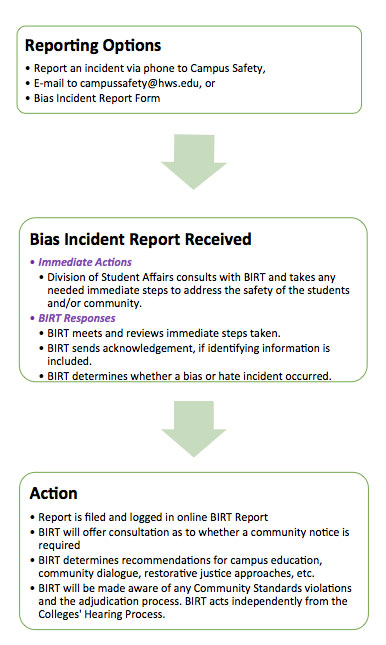Frequently AskedQuestions
What is a bias incident or hate crime?
Bias Incident
A Bias Incident is characterized as a behavior or act—verbal, written or physical—which is personally directed against or targets an individual or group based on perceived or actual characteristics such as race, color, religious belief, sex, marital status, sexual orientation, gender identity or expression, national or ethnic origin, disability, veteran status, or age; behaviors like this constitute violations of the Colleges’ Community Standards. The kinds of incidents that may constitute a bias incident, include but are not limited to, threatening telephone calls or mail (including electronic mail), graffiti, physical assault, harassment, stalking, vandalism, destruction of personal property, or coercion. The Colleges encourage the reporting of all hate crimes and bias incidents.
Hate Crime
Federal and state statutes on hate crime vary in terms of the acts and categories of bias that are covered. Under New York State Law, a hate crime is committed when a person commits a specified offense and (1) either intentionally selects the person against whom the offense is committed or intended to be committed, or (2) intentionally commits the act or acts because of a belief or perception of the person’s or group’s race, color, national origin, ancestry, sex, religion, religious practice, age, disability, or sexual orientation, regardless of whether the belief or perception is correct. When a person is convicted of a hate crime pursuant to Article 485 of New York State Hate Crimes Act of 2000, the law provides for the level of a hate crime to be deemed one category higher than the specified offense, when that specified offense is a misdemeanor or a class C, D or E felony. When the specified offense is a class B or A1 felony, the term of sentence is enhanced.
Note: All hate crimes are bias incidents, but not all bias incidents are hate crimes.
What is the Bias Incident Response Team (BIRT)?
Acting as the Colleges’ “first response” team when dealing with reported bias incidents, the committee is made up of campus partners who evaluate incidents and recommend potential responses for the community.
What Happens Following a Report?
To review our protocol, please click here.
In collaboration with Student Affairs, BIRT thoroughly reviews each report and reaches out to affected individuals as needed, and determines the proper resources, support, and educational interventions to follow the incident. The response team meets monthly as well as needed for emergencies.
BIRT offers recommendations and interventions for the community. As such, it is not responsible for investigating or adjudicating alleged incidents of bias or hate crimes, or any of the Colleges’ Community Standards. However, Campus Safety and Student Affairs will keep the BIRT team apprised of results of investigations through the Vice President for Student Affairs. When there is a potential hate crime, local law enforcement handles investigations in cooperation with Campus Safety.
Are you considering submitting a BIRT report but want more information? Ready to submit a BIRT report now? Please visit our BIRT Protocol page.
The BIRT summary report for the 2022-2023 academic year can be found here.
Regarding Incidents Falling Under Title IX
Concerns relating to sex, gender identity, and sexual orientation discrimination are also a form of bias. The Title IX Office oversees reports by students, faculty, and staff of conduct prohibited under the Colleges’ Title IX and Sexual Misconduct Policy. The Title IX Office coordinates the Colleges’ response and/or resolution to all reports. Title IX, and other legal compliance, requires calendar year reporting. The most recent report for the 2021 calendar year is available here and the Colleges’ 2022 report will be available in October of 2023 on the Campus Safety website. If you have additional questions, please contact the Colleges' Title IX Office (titleix@hws.edu); you may also reach out to Title IX Coordinator Amanda Jantzi (jantzi@hws.edu).

